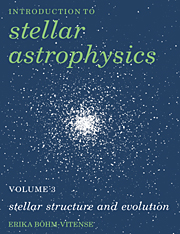Book contents
- Frontmatter
- Contents
- Preface
- 1 Introduction
- 2 Hydrostatic equilibrium
- 3 Thermal equilibrium
- 4 The opacities
- 5 Convective instability
- 6 Theory of convective energy transport
- 7 Depths of the outer convection zones
- 8 Energy generation in stars
- 9 Basic stellar structure equations
- 10 Homologous stars in radiative equilibrium
- 11 Influence of convection zones on stellar structure
- 12 Calculation of stellar models
- 13 Models for main sequence stars
- 14 Evolution of low mass stars
- 15 Evolution of massive stars
- 16 Late stages of stellar evolution
- 17 Observational tests of stellar evolution theory
- 18 Pulsating stars
- 19 The Cepheid mass problem
- 20 Star formation
- Appendix Radiative energy transport in stars
- Problems
- References
- Index
12 - Calculation of stellar models
Published online by Cambridge University Press: 08 January 2010
- Frontmatter
- Contents
- Preface
- 1 Introduction
- 2 Hydrostatic equilibrium
- 3 Thermal equilibrium
- 4 The opacities
- 5 Convective instability
- 6 Theory of convective energy transport
- 7 Depths of the outer convection zones
- 8 Energy generation in stars
- 9 Basic stellar structure equations
- 10 Homologous stars in radiative equilibrium
- 11 Influence of convection zones on stellar structure
- 12 Calculation of stellar models
- 13 Models for main sequence stars
- 14 Evolution of low mass stars
- 15 Evolution of massive stars
- 16 Late stages of stellar evolution
- 17 Observational tests of stellar evolution theory
- 18 Pulsating stars
- 19 The Cepheid mass problem
- 20 Star formation
- Appendix Radiative energy transport in stars
- Problems
- References
- Index
Summary
Schwarzschild's method
Before we can discuss the detailed structure of the stars on the main sequence we have to outline the methods by which it can be calculated. In Chapter 10 we have compared homologous stars on the main sequence. While we were able to see how temperatures and pressures in the stars change qualitatively with changing mass and chemical composition, we have never calculated what the radius and effective temperature of a star with a given mass really is. In order to do this we need to integrate the basic differential equations, which determine the stellar structure as outlined in Chapter 9. Two methods are in use: Schwarzschild's method and Henyey's method.
Schwarzschild's method is described in his book on stellar structure and evolution (1958). The basic differential equations are integrated both from the inside out and from the outside in. In the dimensionless form the differential equations for the integration from the outside in contain the unknown constant C (see Chapter 9), for the integration from the inside out the differential equations also contain the unknown constant D. A series of integrations from both sides of the star is performed for different values of these constants. The problem then is to find the correct values for the constants C and D and thereby the correct solutions for the stellar structure. At some fitting point Xf = (r/R)f we have to fit the exterior and the interior solutions together in order to get the solution for the whole star. At this fitting point we must of course require that pressure and temperature are continuous.
- Type
- Chapter
- Information
- Introduction to Stellar Astrophysics , pp. 141 - 154Publisher: Cambridge University PressPrint publication year: 1992

